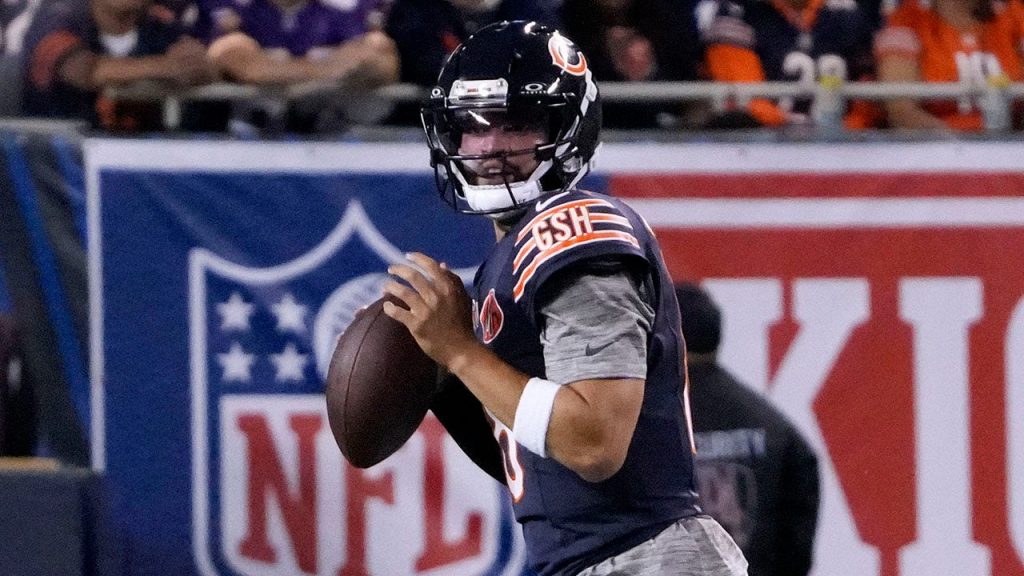Caleb Williams’ Uniform Choice Sparks Debate During Bears-Vikings Matchup
In Monday night’s closely contested game between the Chicago Bears and Minnesota Vikings, rookie quarterback Caleb Williams found himself at the center of an unexpected controversy. As Williams took the field wearing a gray undershirt beneath his Bears jersey, social media erupted with opinions about his uniform choice. The debate over this seemingly minor detail continued throughout the evening as the Bears ultimately fell to the Vikings 27-24. While some fans defended Williams’ personal style, others questioned whether the unconventional undershirt violated NFL uniform policies or distracted from team unity. Despite the attention on his attire, Williams’ performance showcased the young quarterback’s potential, even as his team struggled to close out what began as a promising game.
The game itself presented a fascinating narrative arc for Williams, with the first-year signal-caller demonstrating both his remarkable talent and the growing pains typical of a rookie quarterback. By halftime, Williams had guided Chicago to a four-point lead, displaying the confidence and playmaking ability that made him such a highly touted prospect. His performance included both a passing and rushing touchdown, highlighting his dual-threat capabilities that have energized Bears fans. Williams finished the game with solid numbers, completing 21 of 35 passes for 210 yards along with his two scores. These statistics, while not spectacular, represented a respectable showing for a young quarterback still adjusting to the speed and complexity of professional football. His connection with rookie receiver Rome Odunze, which resulted in a late touchdown to bring the Bears within striking distance, offered a glimpse of what could become a dynamic partnership for years to come.
As the second half unfolded, however, Chicago’s offense lost momentum at critical moments, preventing them from building on their early advantage. The Bears’ offensive struggles included multiple punts and a missed field goal following a promising 11-play drive that covered 44 yards. While Chicago’s defense contributed significantly with cornerback Nahshon Wright’s pick-six, the offense couldn’t capitalize on these opportunities to put the game away. This offensive inconsistency allowed Vikings quarterback J.J. McCarthy to orchestrate a comeback, engineering three touchdown drives that ultimately proved decisive. When Williams did get one final chance to respond, time had nearly expired, leaving the Bears just short in their comeback attempt. This pattern of promising drives stalling at crucial moments highlighted the ongoing development process for both Williams and the Bears’ offense as a whole.
Bears head coach Ben Johnson addressed the loss with a candid assessment, acknowledging that mistakes ultimately determined the outcome. “We said going into Week 1 that the team that would make the least number of mistakes would win the game, and unfortunately, we were on the wrong side of that,” Johnson explained in his post-game comments. The coach didn’t shy away from including himself in this critique, adding, “We made too many there late in the game, myself included. There were a number of things that I could have done better.” This accountability from the coaching staff reflects the Bears’ organizational approach to development – recognizing that growth involves acknowledging shortcomings at all levels, from rookie players to experienced coaches. Johnson’s willingness to share responsibility may help maintain team unity as they work to improve following this disappointing result.
The larger context surrounding Williams extends beyond a single game or uniform choice. As the face of the Bears’ franchise rebuilding efforts, everything the young quarterback does faces intense scrutiny. His arrival in Chicago brought renewed hope to a storied franchise that has struggled to find consistent quarterback play for generations. The pressure on Williams to transform the organization is immense, with every decision – from his play-calling to his attire – analyzed through the lens of leadership and professionalism. This microscopic examination represents the reality for first-round quarterbacks, particularly those selected to revitalize historically significant teams. Despite this pressure, Williams has generally maintained composure beyond his years, focusing on development rather than responding to critics. Monday’s game, despite the loss, demonstrated his potential to handle both the physical and mental challenges of leading an NFL franchise.
Looking forward, the Bears and their young quarterback face the typical challenges of building consistency while learning from disappointments. The narrow loss to Minnesota, while frustrating, provided valuable experience for Williams in high-pressure situations against division rivals. His ability to connect with fellow rookie Odunze for a crucial late touchdown demonstrated chemistry that should develop further as the season progresses. For Chicago’s coaching staff, the challenge involves building an offensive system that maximizes Williams’ unique talents while providing the structure necessary for a young quarterback’s development. As for the uniform debate that briefly captured social media’s attention, it likely represents merely a footnote in what Bears fans hope will be a long and successful career for their franchise quarterback. The real story of Caleb Williams will be written not by his choice of undershirt, but by his development into the leader Chicago has sought for decades.


